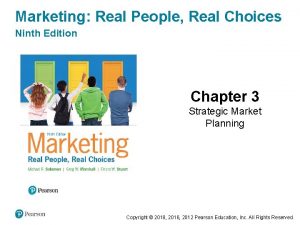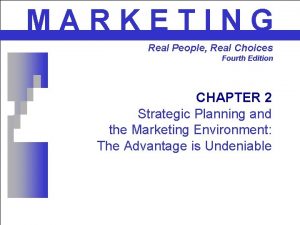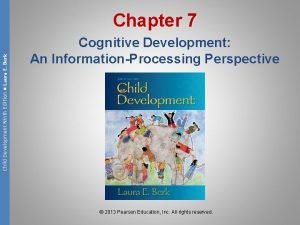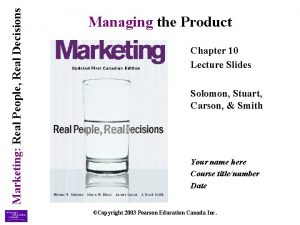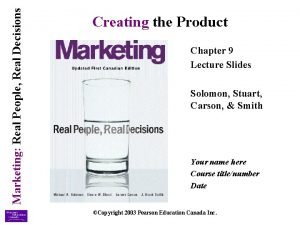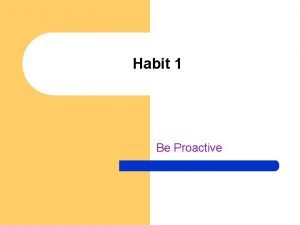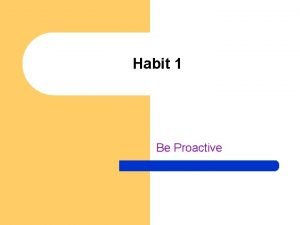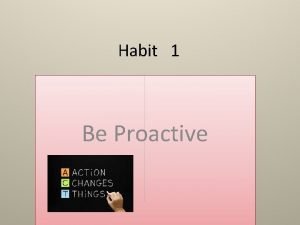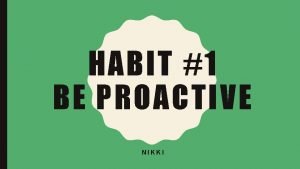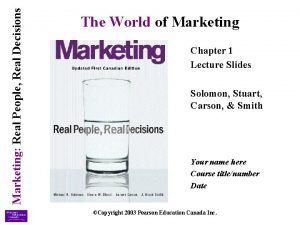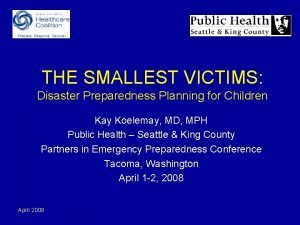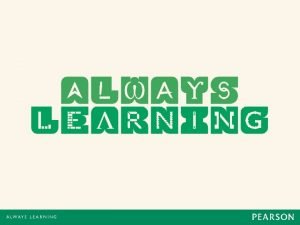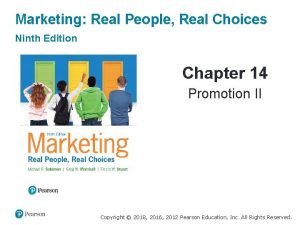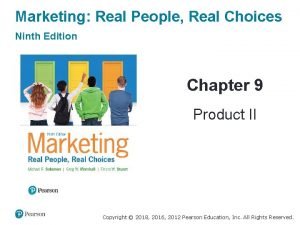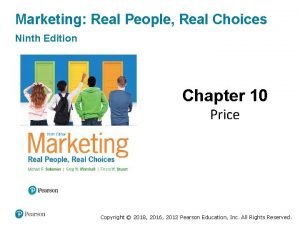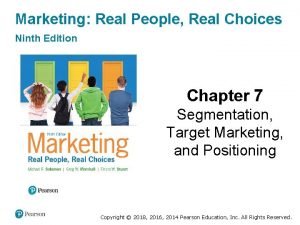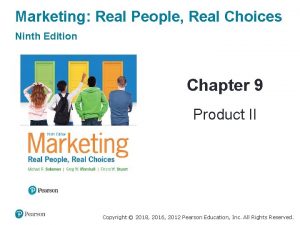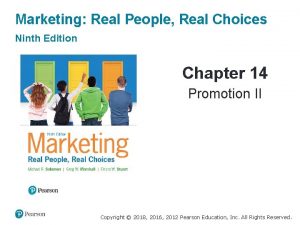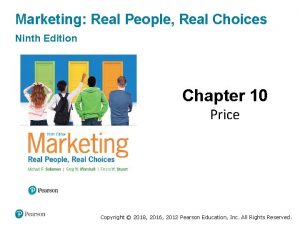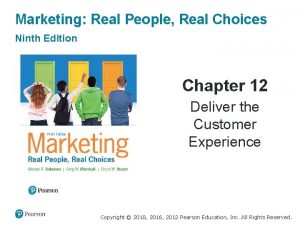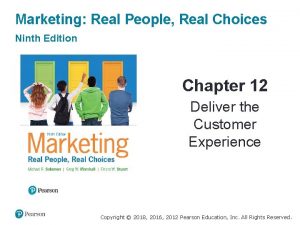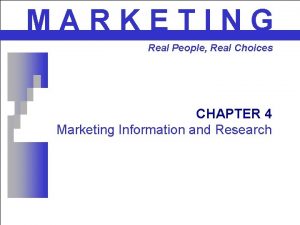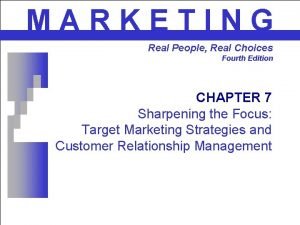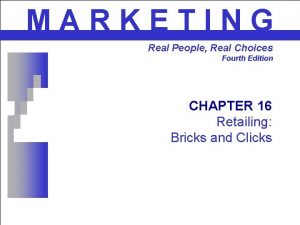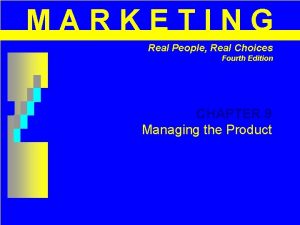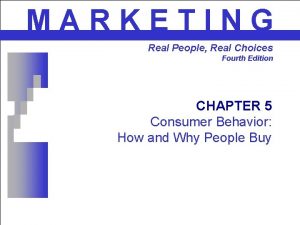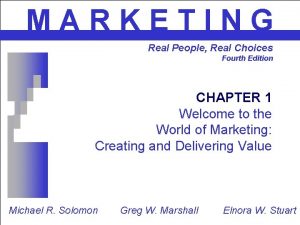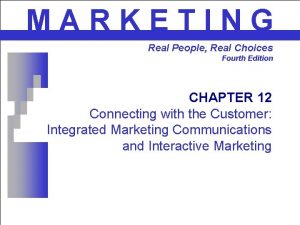Marketing Real People Real Choices Ninth Edition Chapter









































- Slides: 41

Marketing: Real People, Real Choices Ninth Edition Chapter 4 Market Research Copyright © 2018, 2016, 2012 Pearson Education, Inc. All Rights Reserved.

Learning Objectives 4. 1 Explain the role of a marketing information system and a marketing decision support system in marketing decision making 4. 2 Understand the concept of customer insights and the role it plays in making good marketing decisions 4. 3 List and explain the steps and key elements of the market research process Copyright © 2018, 2016, 2012 Pearson Education, Inc. All Rights Reserved

Real People, Real Choices: Campbell’s Soup • Which option should be pursued? § Option 1: Carve out a new space within the soup portfolio for this millennial-driven soup offering. § Option 2: Reposition an existing brand to be the face of the millennial portfolio. § Option 3: Don’t take the risk, and stick with our existing solutions. Copyright © 2018, 2016, 2012 Pearson Education, Inc. All Rights Reserved

Knowledge is Power • Successful market planning depends upon informed decision making. § Developing marketing objectives § Selecting target markets § Positioning products § Developing 4 Ps strategies • Information is the fuel that runs the marketing engine. Copyright © 2018, 2016, 2012 Pearson Education, Inc. All Rights Reserved

Marketing Research Ethics • Marketing research ethics refers to taking an aboveboard approach in conducting market research that does no harm to the participant. § Privacy issues § Confidentiality issues Copyright © 2018, 2016, 2012 Pearson Education, Inc. All Rights Reserved

Figure 4. 1 The Marketing Information System Copyright © 2018, 2016, 2012 Pearson Education, Inc. All Rights Reserved

Internal Company Data • Information generated from within the company § Used to produce reports on sales and marketing activities § Commonly accessed via secure intranets Copyright © 2018, 2016, 2012 Pearson Education, Inc. All Rights Reserved

Market Intelligence (1 of 2) • Gathered via monitoring of everyday data sources, observations, and discussions with sales representatives. Copyright © 2018, 2016, 2012 Pearson Education, Inc. All Rights Reserved

Market Intelligence (2 of 2) • Market intelligence system • Information may come from mystery shoppers, speaking with buyers, trade shows, purchasing, or using reverse engineering Copyright © 2018, 2016, 2012 Pearson Education, Inc. All Rights Reserved

Market Research • Refers to the process of collecting, analyzing, and interpreting data about customers, rivals, and the business environment § Syndicated research § Custom research reports Q-Scores Nielsen Ratings Copyright © 2018, 2016, 2014 Pearson Education, Inc. All Rights Reserved.

Acquired Databases • Externally sourced databases can be used to collect various types of useful information § Noncompeting businesses § Government databases • Misuse of databases can be problematic and has led to “do-not-call” lists and anti-spamming laws Copyright © 2018, 2016, 2012 Pearson Education, Inc. All Rights Reserved

Figure 4. 2 Marketing Decision Support System Copyright © 2018, 2016, 2012 Pearson Education, Inc. All Rights Reserved

Table 4. 1 Examples of Questions an MIS Answers (1 of 2) Questions an MIS Answers What were our company sales of each product during the past month and the past year? What changes are happening in sales in our industry, and what are the demographic characteristics of consumers whose purchase patterns are changing the most? What are the best media to reach a large proportion of heavy, medium, or light users of our product? Copyright © 2018, 2016, 2012 Pearson Education, Inc. All Rights Reserved

Table 4. 1 Examples of Questions an MDSS Answers (2 of 2) Questions an MDSS Answers Has our decline in sales simply reflected changes in overall industry sales, or is there some portion of the decline that industry changes cannot explain? Do we see the same trends in our different product categories? Are the changes in consumer trends similar among all our products? What are the demographic characteristics of consumers who seem to be the most and the least loyal? If we change our media schedule by adding or deleting certain media buys, will we reach fewer users of our product? Copyright © 2018, 2016, 2012 Pearson Education, Inc. All Rights Reserved

MIS, MSDS and Customer Insights • To make good decisions, marketing managers need timely access to quality information! § A firm’s MIS stores and analyses data from a variety of sources § A firm’s MSDS makes it easier to access the MIS and find answers to specific “what-if” questions Suppose your university hired you to lead its customer insights team. What sorts of questions might your MIS and MSDS systems answer? Copyright © 2018, 2016, 2012 Pearson Education, Inc. All Rights Reserved

Customer Insights and Marketing • Goal of the Marketing Insights function -transform data into information § Data are raw unorganized facts § Information is interpreted data • More complicated than it sounds § Massive amounts of data § Much data is unstructured § Functional silos Copyright © 2018, 2016, 2012 Pearson Education, Inc. All Rights Reserved

Figure 4. 3 Steps in the Market Research Process Copyright © 2018, 2016, 2012 Pearson Education, Inc. All Rights Reserved

Step 1: Define the Research Problem • Specify the research objectives § What questions will the research attempt to answer? • Identify the consumer population of interest § What are the characteristics of the consumer group(s) of interest? • Place the problem in an environmental context § What factors in the firm’s internal and external business environment might influence the situation? Copyright © 2018, 2016, 2012 Pearson Education, Inc. All Rights Reserved

Step 2: Determine the Research Design • Once the problem is isolated, the next step is to determine a ‘plan of attack’ § A research design is a plan that specifies what information marketers will collect and what type of study they will do • Research designs fall into two categories: § Secondary data § Primary data Copyright © 2018, 2016, 2012 Pearson Education, Inc. All Rights Reserved

Research with Secondary Data • Does information already exist? • Trade associations compile data • Secondary data can save time and money Copyright © 2018, 2016, 2012 Pearson Education, Inc. All Rights Reserved

Figure 4. 4 Market Research Designs Copyright © 2018, 2016, 2014 Pearson Education, Inc. All Rights Reserved

Research with Primary Data • Primary data refers to data collected by the firm to address a specific question • § When a company needs to make a specific decision, secondary data may not be enough! § May include demographics, psychological info, awareness, attitudes, and opinions Exploratory, descriptive, and causal research Copyright © 2018, 2016, 2012 Pearson Education, Inc. All Rights Reserved

Exploratory Research • Exploratory research is useful for: • § Gaining better understanding of problem § Identifying new opportunities Often qualitative in nature § Focus § Market research online community (MROC) § Case studies § Ethnographies Copyright © 2018, 2016, 2012 Pearson Education, Inc. All Rights Reserved

Descriptive Research • Descriptive research § Systematically investigate marketing problem § Results expressed in quantitative terms § Cross-sectional vs. longitudinal designs Copyright © 2018, 2016, 2012 Pearson Education, Inc. All Rights Reserved

Causal Research • Causal research § Attempts to identify cause-and -effect § Often involves experiments § Independent and dependent variables Sales of beer and diapers are correlated, but does one cause the other? Copyright © 2018, 2016, 2012 Pearson Education, Inc. All Rights Reserved

Ethical/Sustainable Decisions in the Real World • Should companies that offer products or services that may pose health risks be allowed to fund research that could suggest that those products share little or no responsibility for those health risks? § Coca-Cola spent $132 million on research from 2010 to 2015 § Research suggested that Americans held an illegitimate fixation on calorie consumption, but didn’t exercise As a marketing executive, is it OK to commission and fund research that supports the position that the product posed no health risk when you are aware that other independent research studies contradict that view? Copyright © 2018, 2016, 2012 Pearson Education, Inc. All Rights Reserved

Step 3: Choose the Method to Collect Primary Data • Primary data collection falls into two broad categories § Survey § Observation • Use of new technologies § Neuromarketing § Virtual stores Copyright © 2018, 2016, 2012 Pearson Education, Inc. All Rights Reserved

Survey Methods • Survey methods are used to interview respondents § Mail questionnaires § Telephone interviews § Face-to-face interviews § Online questionnaires Copyright © 2018, 2016, 2012 Pearson Education, Inc. All Rights Reserved

Table 4. 2 Advantages and Disadvantages of Survey Data Collection Methods (1 of 2) Data Collection Method Advantages Disadvantages Mail questionnaires • Respondents feel anonymous • It may take a long time for questionnaires to be returned Blank • Low cost Blank • Good for on-going research Blank • Low rate of response; many consumers may not return questionnaires • Inflexible questionnaire format • Length of questionnaire is limited by respondents’ interest in the topic Blank • Unclear who is responding Blank Telephone interviews • Fast • No assurance that respondents are being honest • Decreasing levels of respondent cooperation Blank • High flexibility in questioning • High likelihood of respondent misunderstanding Blank • Low cost • Limited interviewer follow-up • Limited questionnaire length Blank • Respondents cannot view materials • Cannot survey households without phones • Consumers screen calls with answering machines and caller ID • Do-not-call lists allow many research subjects to opt out of participation • Unclear whether respondents understand the questions Copyright © 2018, 2016, 2014 Pearson Education, Inc. All Rights Reserved

Table 4. 2 Advantages and Disadvantages of Survey Data Collection Methods (2 of 2) Data Collection Method Advantages Disadvantages Face-to-face interviews • Flexibility of questioning • High cost • Can use long questionnaires • Interviewer bias a problem Blank • Can determine whether respondents have trouble understanding questions • Take a lot of time • Can use visuals or other materials Blank • Instantaneous data collection and analysis • Unclear who is responding • Questioning very flexible • No assurance that respondents are being honest • Low cost • Limited questionnaire length • No interviewer bias • Unable to determine whether respondent understands the question Blank • No geographic restrictions • Self-selected samples Blank • Can use visuals or other materials Blank Online questionnaires Blank Copyright © 2018, 2016, 2014 Pearson Education, Inc. All Rights Reserved

Observational Methods • Data collection approach in which researcher records consumer behaviors, often without their knowledge § Personal observation § Unobtrusive measures § Mechanical systems Copyright © 2018, 2016, 2012 Pearson Education, Inc. All Rights Reserved

Online Research • Two major types of online research § Gathering info from online surfing (e. g. , cookies) § Gathering info via online sources (e. g. , hash tag searches) • Predictive technology uses shopping patterns of large numbers of people to determine which products are likely to be purchased if others are Copyright © 2018, 2016, 2012 Pearson Education, Inc. All Rights Reserved

Bounce Rate • Bounce rate is a measure of how many visitors come to a page on a website and leave without viewing any other pages. • Marketers use bounce rates to determine whether an entry page effectively generates visitor interest. Copyright © 2018, 2016, 2012 Pearson Education, Inc. All Rights Reserved

Data and Measurement Quality Issues • Quality of market research insights based on “garbage in, garbage out!” • Three key considerations: § Validity § Reliability § Representativeness Copyright © 2018, 2016, 2012 Pearson Education, Inc. All Rights Reserved

Step 4: Design the Sample (1 of 2) • Probability sampling § Each member of the population has some known chance of being included (example: action films vs. “chick flicks”) § Simple random sample § Systematic sampling procedure § Stratified sample Copyright © 2018, 2016, 2012 Pearson Education, Inc. All Rights Reserved

Step 4: Design the Sample (2 of 2) • Nonprobability sampling § A sample in which personal judgment is used to select respondents (example: surveying random individuals at your favorite restaurant) § Convenience sample § Quota sample Copyright © 2018, 2016, 2012 Pearson Education, Inc. All Rights Reserved

Step 5: Collect the Data • The quality of research conclusions is only as good as the data used to generate them • Challenges to gathering data in foreign countries § Cultural issues § Language issues Copyright © 2018, 2016, 2012 Pearson Education, Inc. All Rights Reserved

Step 6: Analyze and Interpret the Data • Data must be analyzed and interpreted to be meaningful! • Tabulation § Arranging data in a table or other summary form to get a broad picture of overall response • Cross-tabulation § Exploring data by sub-groups in order to see how results vary across categories Copyright © 2018, 2016, 2012 Pearson Education, Inc. All Rights Reserved

Table 4. 3 Examples of Data Tabulation and Cross-Tabulation Tables Fat Content Preference (number and percentages of responses) Do you prefer a meal with high-fat content, medium-fat content, or low-fat content? Questionnaire Response Number of Responses Percentage of Responses 21 179 150 350 6 51 43 100 High fat Medium fat Low fat Total Fat Content Preference by Gender (number and percentages of responses) Do you prefer a meal with high-fat content, medium-fat content, or low-fat content? Questionnaire Response Number of Females Percentage of Females Number of Males Percentage of Males Total Number Total Percentage High fat 4 2 17 10 21 6 Medium fat 68 39 111 64 179 51 Low fat 103 59 47 27 150 43 Total 175 100 350 100 Copyright © 2018, 2016, 2014 Pearson Education, Inc. All Rights Reserved

Step 7: Prepare the Research Report • Research reports typically include the following sections: § Executive summary § Description of research methods § Discussion of study results § Limitations of study § Conclusions and recommendations Copyright © 2018, 2016, 2012 Pearson Education, Inc. All Rights Reserved

Copyright © 2018, 2016, 2014 Pearson Education, Inc. All Rights Reserved
 Slidetodoc.com
Slidetodoc.com Ch 9 ream people real choice case study
Ch 9 ream people real choice case study Marketing real people real choices
Marketing real people real choices Levels of analysis psychology
Levels of analysis psychology Macroeconomics
Macroeconomics Human anatomy & physiology edition 9
Human anatomy & physiology edition 9 General adaptation syndrome
General adaptation syndrome Social psychology ninth edition
Social psychology ninth edition Biology ninth edition
Biology ninth edition Child development ninth edition
Child development ninth edition Berk 2013 child development
Berk 2013 child development Abnormal psychology ronald j comer 9th edition
Abnormal psychology ronald j comer 9th edition Psychology ninth edition in modules
Psychology ninth edition in modules Psychology ninth edition david g myers
Psychology ninth edition david g myers Biology ninth edition
Biology ninth edition Campbell ninth edition
Campbell ninth edition Marketing real people real decisions
Marketing real people real decisions Marketers classify innovations based on their
Marketers classify innovations based on their Proactive
Proactive Proactive people make choices based on
Proactive people make choices based on Whats proactive
Whats proactive Reactive people make choices based on
Reactive people make choices based on Non national loyalties
Non national loyalties How do nationalist loyalties shape people's choices
How do nationalist loyalties shape people's choices Marketing real people
Marketing real people Ninth commandment catholic
Ninth commandment catholic The sixth and ninth commandments
The sixth and ninth commandments Phos root word
Phos root word Whats ramadan
Whats ramadan William blount 9th grade academy
William blount 9th grade academy Lower ninth ward
Lower ninth ward 17 classical menu with example
17 classical menu with example Ninth district pta
Ninth district pta Using mis 10th edition
Using mis 10th edition Mis
Mis Lesson 2 making responsible decisions and setting goals
Lesson 2 making responsible decisions and setting goals Economics unit 1 lesson 2 difficult choices
Economics unit 1 lesson 2 difficult choices Chapter 9 making healthy food choices
Chapter 9 making healthy food choices How do career choices affect your income? explain
How do career choices affect your income? explain Chapter 1 section 3 economic choices and decision making
Chapter 1 section 3 economic choices and decision making Chapter 1 limits alternatives and choices
Chapter 1 limits alternatives and choices Marketing management (arab world edition)
Marketing management (arab world edition)

